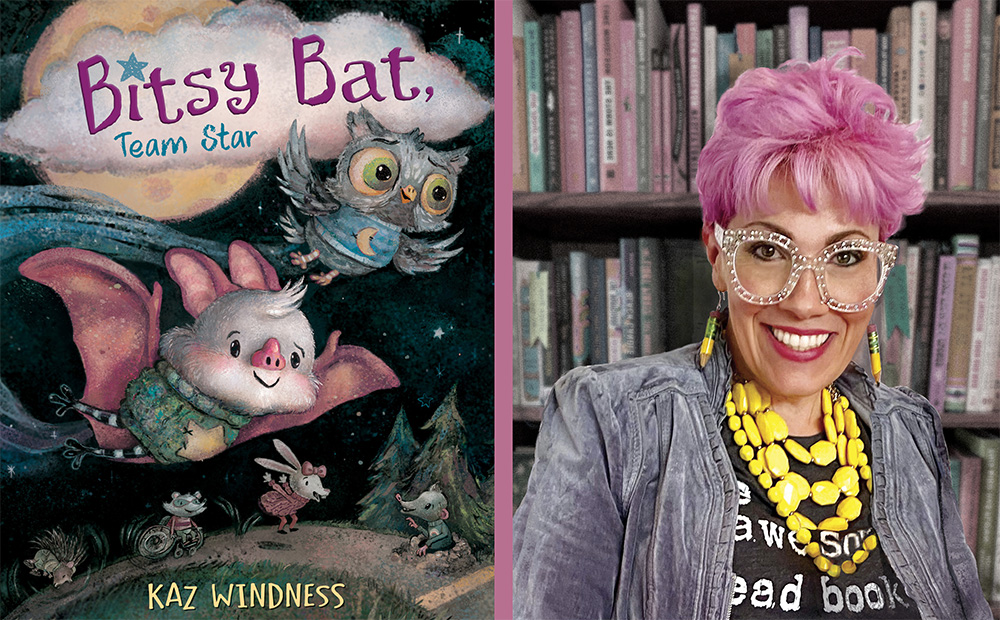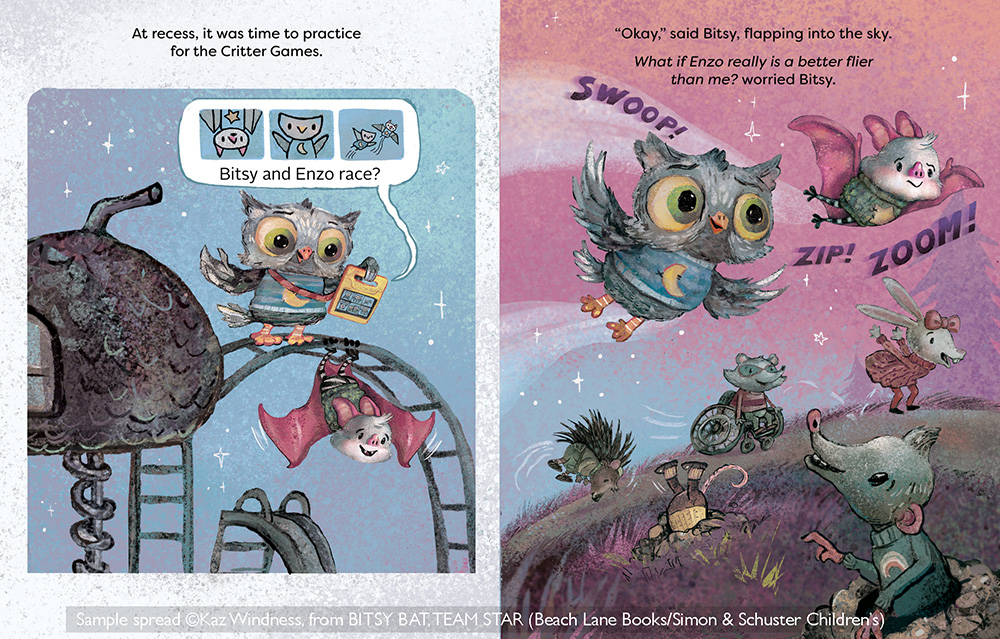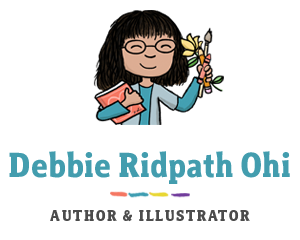
Kaz Windness is the Geisel award-winning, genre-crossing illustrator and author of funny and heart-warming books for young readers. Proudly neurodivergent (ASD/ADHD), Kaz specializes in character-driven books celebrating inclusivity, grit, and kindness. Her many books include Swim, Jim!, Worm and Caterpillar are Friends, When You Love a Book, and Bitsy Bat, School Star. She is a professor of illustration at the Rocky Mountain College of Art + Design and founder of The Cuddlefish Academy, where she inspires students to tell stories with pictures. More info on her website, Linktree. Main socials: Bluesky, Instagram.
Bitsy Bat, Team Star
Published by Beach Lane Books, Simon & Schuster Children’s
ISBN13: 9781665947558
Grades: P-3 / Ages: 4-8
Synopsis:
“Bitsy meets a new nonspeaking student at school and learns the importance of being a star teammate and friend in this sequel to the “darling” (Kirkus Reviews, starred review) Bitsy Bat, School Star from Theodor Seuss Geisel Honor–winning author-illustrator Kaz Windness.”
Q. What was your writing process for BITSY BAT, TEAM STAR?
I’ve heard that sequels are much harder to write, and I found this to be true. I couldn’t let down readers who loved Bitsy Bat, School Star. I had to build on Bitsy’s world, but introduce a new, fun, and exciting story that would also show a different aspect of autism.
Characters always come first for me, and I had a drawing of a non-speaking owl character who uses an AAC device. I named him Enzo after my friend Laura’s son. What if Enzo was a new student at Crittercrawl Elementary? I knew that Bitsy would either feel excited or jealous to have another flier in class, and my editor, Catherine Laudone, encouraged me to think of action-filled plots. I thought back to my elementary school days and recalled our school Olympics with events for both academics and athletics. This gave us a reason for Bitsy to fly against Enzo, and also a reason she might worry that her friendships are in jeopardy.

This story went through dozens of drafts and revisions. My editor and I talked a lot about Bitsy’s likeability. It was important to me to show an honest portrayal of a kid struggling with competition and her place in her friend group. Bitsy is never intentionally mean, but she does hurt Enzo’s feelings when she loses their first race. I know what it’s like to be on both sides of this interaction. Communication difficulties and friendship struggles are something I’ve dealt with my whole life. I also wanted the story to reflect that autistics are lovable and worthy of inclusion even if they aren’t performing likability or a valued service to neurotypical standards.
I’m glad we stuck it out through the struggles of writing BITSY BAT, TEAM STAR. I hope readers are inspired and delighted by the story and come away with a better understanding of differences like autism.
Q. What was your illustration process for BITSY BAT, TEAM STAR?
I usually start with sketches in my sketch book. I’m a very messy sketcher. I used to edit the life out of my drawings in the revision process, but now I try to stay lose but legible. My wonderful art director, Laurent Linn, knows that I will clean things up in the painting process, so he allows the looseness. His biggest note is always “consistent characters, please,” but he also pushes me to show a variety of emotion and makes sure the story is visually clear for young readers.
I paint digitally, usually in Photoshop, using textural brushes. Grutbrush is a great source for affordable and effective digital brushes. I use the lasso tool and spray in the selected shape with my texture brush. There’s probably a faster way to do this, but I love how this builds depth and keeps my silhouettes crisp and clear without using a holding line or outline.
The BITSY BAT books are 48-pages, so the painting process takes me about three months. I find that using a spread sheet and checking off each page as I finish them helps me feel like I’m making progress. It’s easy to feel overwhelmed with bigger illustration projects, but breaking it into small, doable chunks really helps.
Q. What do you hope young readers will take away from BITSY BAT, TEAM STAR?
I hope they enjoy the fun and excitement of a teamwork and racing story. I hope they learn something about autism or feel more accepted as someone with differences. I hope these stories inspire more inclusive schools and classrooms. There’s a scene in this book where Bitsy is taking a break in a sensory room. She has her soft, fuzzy blanket and a stuffy. I’ve provided ideas for sensory tools at BitsyBat.com, along with complimentary curriculum-based educator lesson plans as well as drawing and coloring sheets.
Q. What advice do you have for young writers and illustrators?
Please resist the urge to use Generative Ai. Ai will never create anything new and it’s not creating anything ethical, either. It’s trained on stolen art and writing, including my work.
I’m worried that the next generation of artists and writers will give up on their own creativity. Being good at art and writing takes a lot of being bad at art and writing, and if I’d had this technology back in my bad art days, it would have been very tempting to use it. But then I’d never have grown the skills and creative muscle I have now. I’m living my dreams and I’m creatively satisfied. I want the next generation to have the same opportunities.
I’m heartened by publishers standing against Ai and siding with human artists, but we are living through difficult times. Keep being yourself; keep being weird; keep making wonderful, flawed but beautiful human art.
More interviews with Kaz on my blog:
Interview with SWIM, JIM! debut picture book author/illustrator, Kaz Windness
Interview with Kaz Windness, BITSY BAT SCHOOL STAR!
Also see more Advice For Young Writers and Illustrators and my Interviews Archive.

